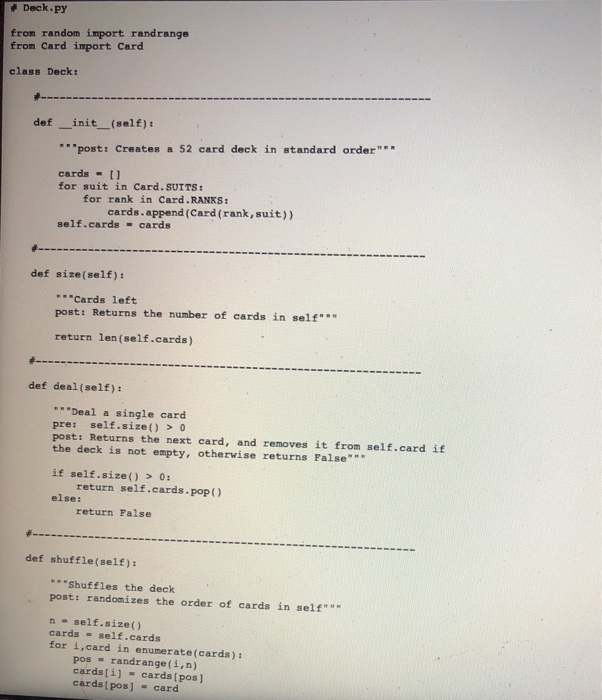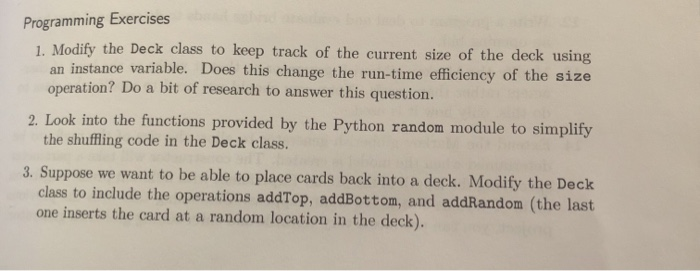Answered step by step
Verified Expert Solution
Question
1 Approved Answer
python 2) Programming Exercises: p 103 / 1, 2, 3- all of these exercises should be implemented in one file Deck.py Test all the operations,
python 


2) Programming Exercises: p 103 / 1, 2, 3- all of these exercises should be implemented in one file Deck.py Test all the operations, send the tests with your HW submission! + Deck.py from random import randrange from Card import Card class Deck: --- def __init__(self): post: Creates a 52 card deck in standard order"** cards = [] for suit in Card. SUITS: for rank in Card. RANKS: cards.append(Card (rank, suit)) self.cards - cards def size(self): **Cards left post: Returns the number of cards in self"** return len(self.cards) def deal(self): Deal a single card pre: self.size() > 0 post: Returns the next card, and removes it from self.card if the deck is not empty, otherwise returns Palse"** if self.size() > 0: return self.cards.pop() else: return false -- - def shuffle(self): ***Shuffles the deck post: randomizes the order of cards in self" n = self.size() cards = self.cards for i,card in enumerate(cards) : pos - randrange(in) cards[i] = cards [pos] cards[pos] = card Programming Exercises 1. Modify the Deck class to keep track of the current size of the deck using an instance variable. Does this change the run-time efficiency of the size operation? Do a bit of research to answer this question. 2. Look into the functions provided by the Python random module to simplify the shuffling code in the Deck class. 3. Suppose we want to be able to place cards back into a deck. Modify the Deck class to include the operations addTop, addBottom, and addRandom (the last one inserts the card at a random location in the deck). 2) Programming Exercises: p 103 / 1, 2, 3- all of these exercises should be implemented in one file Deck.py Test all the operations, send the tests with your HW submission! + Deck.py from random import randrange from Card import Card class Deck: --- def __init__(self): post: Creates a 52 card deck in standard order"** cards = [] for suit in Card. SUITS: for rank in Card. RANKS: cards.append(Card (rank, suit)) self.cards - cards def size(self): **Cards left post: Returns the number of cards in self"** return len(self.cards) def deal(self): Deal a single card pre: self.size() > 0 post: Returns the next card, and removes it from self.card if the deck is not empty, otherwise returns Palse"** if self.size() > 0: return self.cards.pop() else: return false -- - def shuffle(self): ***Shuffles the deck post: randomizes the order of cards in self" n = self.size() cards = self.cards for i,card in enumerate(cards) : pos - randrange(in) cards[i] = cards [pos] cards[pos] = card Programming Exercises 1. Modify the Deck class to keep track of the current size of the deck using an instance variable. Does this change the run-time efficiency of the size operation? Do a bit of research to answer this question. 2. Look into the functions provided by the Python random module to simplify the shuffling code in the Deck class. 3. Suppose we want to be able to place cards back into a deck. Modify the Deck class to include the operations addTop, addBottom, and addRandom (the last one inserts the card at a random location in the deck) 


Step by Step Solution
There are 3 Steps involved in it
Step: 1

Get Instant Access to Expert-Tailored Solutions
See step-by-step solutions with expert insights and AI powered tools for academic success
Step: 2

Step: 3

Ace Your Homework with AI
Get the answers you need in no time with our AI-driven, step-by-step assistance
Get Started


